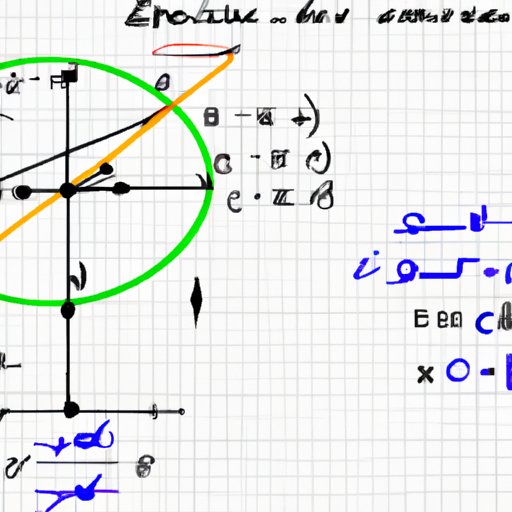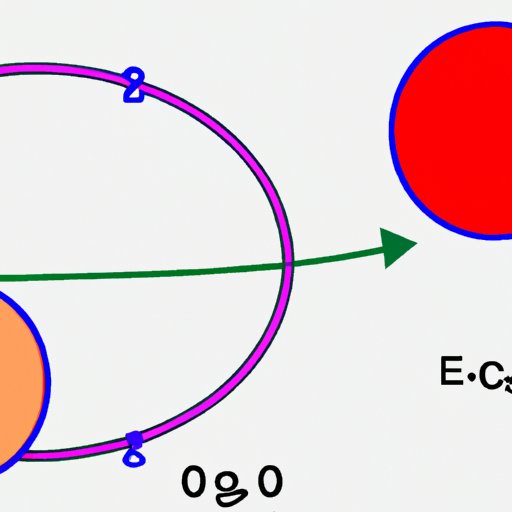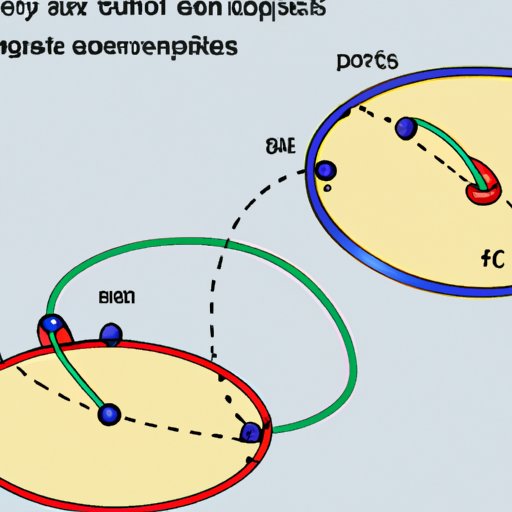Introduction
Have you ever looked up at the night sky and wondered why the planets travel in an elliptical orbit? This article explores why planets travel in elliptical orbits, delving into the physics and mathematics of this phenomenon, as well as examining the history of astronomical discoveries.
Exploring the Physics Behind Elliptical Orbits
The physics behind why planets travel in elliptical orbits is rooted in Isaac Newton’s three laws of motion, which state that an object in motion will remain in motion unless acted upon by an outside force. According to Newton’s second law of motion, a planet’s velocity is determined by the gravitational force of other bodies in the universe. This means that when a planet is closer to another body, such as a star, it experiences a greater gravitational force, which causes its velocity to increase. Conversely, when the planet is further away from the other body, it experiences a lesser gravitational force, causing its velocity to decrease.
In addition to Newton’s laws of motion, the principle of conservation of energy also plays an important role in explaining why planets travel in elliptical orbits. According to this principle, the total amount of energy in a system remains constant over time. In the case of planetary orbits, this means that the sum of the kinetic and potential energies of a planet must remain constant. Therefore, when a planet is closer to a star and experiencing a stronger gravitational pull, its kinetic energy increases while its potential energy decreases, and vice versa when the planet is further away.
Examining the History of Astronomical Discoveries Regarding Elliptical Orbits
The history of astronomical discoveries regarding elliptical orbits began in the 17th century with Johannes Kepler’s three laws of planetary motion. These laws, which were based on observations made by Tycho Brahe, stated that a planet’s orbit is an ellipse with the sun at one of the foci, that a line joining a planet to the sun sweeps out equal areas in equal times, and that the square of a planet’s orbital period is proportional to the cube of its semi-major axis. While these laws helped to explain the shape of planetary orbits, they did not provide an explanation for why planets travel in elliptical orbits.
It was not until 1687 that Isaac Newton proposed his law of universal gravitation, which provided an explanation for why planets travel in elliptical orbits. According to Newton’s law, all objects in the universe exert a gravitational force on each other, and this force is proportional to the product of their masses and inversely proportional to the square of the distance between them. This law explains why planets experience a greater gravitational force when they are closer to the sun and a lesser gravitational force when they are further away, thus causing them to travel in elliptical orbits.

Investigating the Mathematical Principles of Elliptical Orbits
In order to fully understand why planets travel in elliptical orbits, it is necessary to examine the mathematical principles of elliptical orbits. The most important of these principles is eccentricity, which is a measure of how “elongated” an ellipse is. Eccentricity is defined as the ratio of the distance between the two foci of an ellipse to its semi-major axis. The higher the eccentricity, the more elongated the ellipse and the greater the difference between the distances of the planet from the two foci. For example, a perfectly circular orbit has an eccentricity of zero, while a highly elongated orbit can have an eccentricity of up to one.
Another important mathematical principle of elliptical orbits is focus and directrix. The focus of an ellipse is the point around which the planet revolves, and the directrix is the line perpendicular to the focus that passes through the center of the ellipse. Together, these two points define the shape of an elliptical orbit.

Comparing Elliptical and Circular Orbits
When comparing elliptical and circular orbits, it is clear that there are advantages and disadvantages to both. One advantage of elliptical orbits is that they are more stable than circular orbits, since they are less affected by perturbations from other planets. This means that the planet’s orbit will remain more consistent over time, making it easier to predict its future position. Additionally, elliptical orbits are more efficient in terms of energy, since the planet does not have to expend as much energy to move around its orbit compared to a circular orbit.
On the other hand, circular orbits have the disadvantage of being more vulnerable to perturbations from other planets. This can cause the orbit to become unstable and unpredictable, making it difficult to accurately predict the future position of the planet. Additionally, circular orbits require the planet to expend more energy to move around its orbit, making them less efficient than elliptical orbits.

Analyzing the Benefits of Elliptical Orbits
The benefits of elliptical orbits are numerous. As mentioned above, elliptical orbits are more stable than circular orbits and thus make it easier to predict the future position of a planet. Additionally, elliptical orbits are more efficient in terms of energy, since the planet does not have to expend as much energy to move around its orbit. Finally, elliptical orbits allow for more precise calculations of the planet’s position, making it easier for astronomers to accurately map the positions of planets and other celestial bodies.
Understanding the Causes of Eccentricity in Planetary Orbits
The causes of eccentricity in planetary orbits can be attributed to a number of factors. One of the most significant of these is the influence of other planets. If a planet’s orbit is close to that of another planet, the gravitational pull of the other planet can cause the orbit to become more elongated. Additionally, tidal forces from the sun or moon can also affect the shape of a planet’s orbit, causing it to become more elongated.
Conclusion
This article explored why planets travel in elliptical orbits, delving into the physics and mathematics of this phenomenon, as well as examining the history of astronomical discoveries. It was found that the physics behind why planets travel in elliptical orbits is rooted in Newton’s laws of motion and the principle of conservation of energy. Additionally, mathematical principles such as eccentricity and focus and directrix were examined, as well as the advantages and disadvantages of elliptical and circular orbits. Finally, the causes of eccentricity in planetary orbits were discussed, including the influence of other planets and the effects of tidal forces.
By understanding why planets travel in elliptical orbits, we can gain a better appreciation of the underlying physics and mathematics of the universe. Furthermore, this knowledge can help us to better predict the future position of planets and other celestial bodies, allowing us to make more accurate maps of the night sky.
(Note: Is this article not meeting your expectations? Do you have knowledge or insights to share? Unlock new opportunities and expand your reach by joining our authors team. Click Registration to join us and share your expertise with our readers.)
